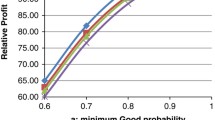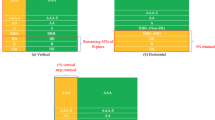Abstract
Risk-averse commercial mortgage lenders follow an underwriting policy with strict limits based on the property’s value and cash flow. A borrower then chooses the initial loan amount and amortization that fit into these requirements and maximizes the investment’s net present value. For an underwriting policy based on typical mortgage ratios, this optimization problem has a closed-form solution. Applying the formula to loan business data from life insurance companies, fluctuations in market parameters and cash flow-based policy limits can explain the major part of the observed variability in initial leverage. This analysis gives further support to observations that initial leverage is endogenous to the underwriting process, while cash flow-based and forward-looking measures are of primary importance in commercial loan risk management.



Similar content being viewed by others
References
Ambrose, B.W., Benjamin, J., Chinloy, P. (1996). Credit restrictions and the market for commercial real estate loans. Real Estate Economics, 24, 1–22.
Ambrose, B.W., Benjamin, J., Chinloy, P. (2003). Bank and nonbank lenders and the commercial mortgage market. Journal of Real Estate Finance and Economics, 26, 81–94.
Archer, W.R., Elmer, P.J., Harrison, D.M., Ling, D.C. (2002). Determinants of multifamily mortgage defaults. Real Estate Economics, 30, 445–473.
Basel Committee on Banking Supervision. (2017). Basel III: Finalising post-crisis reforms. Bank for International Settlements publication.
Cannaday, R.E., & Yang, T.L.T. (1995). Optimal interest rate-discount points combination: strategy for mortgage contract terms. Real Estate Economics, 23, 65–83.
Cannaday, R.E., & Yang, T.T. (1996). Optimal leverage strategy: capital structure in real estate investments. Journal of Real Estate Finance and Economics, 13, 263–271.
Cho, H., Ciochetti, B.A., Shilling, J.D. (2013). Are commercial mortgage defaults affected by tax considerations? Journal of Real Estate Finance and Economics, 46, 1–23.
Ciochetti, B.A., Deng, Y., Lee, G., Shilling, J.D. Yao. (2003). A proportional hazards model of commercial mortgage default with originator bias. Journal of Real Estate Finance and Economics, 27, 5–23.
Gau, G.W., & Wang, K. (1990). Capital structure decisions in real estate investment. AREUEA Journal, 18, 501–521.
Giambona, E., Harding, J.P., Sirmans, C.F. (2008). Explaining the variation in REIT capital structure: the role of asset liquidation value. Real Estate Economics, 36, 111–137.
Griffiths, A. (2001). Pricing of risk and the cost of money: how banks are pricing property funding. Briefings in Real Estate Finance, 1, 214–218.
Grovenstein, R.A., Harding, J.P., Sirmans, C.F., Thebpanya, S., Turnbull, G.K. (2005). Commercial mortgage underwriting: how well do lenders manage the risks? Journal of Housing Economics, 14, 355–383.
Jacob, D.P., & Manzi, J.M. (2005). CMBS credit protection and underwriting standards: have they declined too far? The Journal of Portfolio Management, 31, 80–90.
Modigliani, M., & Miller, M.H. (1958). The cost of capital, corporation finance and the theory of investment. The American Economic Review, 48, 261–297.
Modigliani, M., & Miller, M.H. (1963). Corporate income taxes and the cost of capital: a correction. The American Economic Review, 53, 433–443.
Peng, L. (2014). How is leverage determined for commercial real estate? RERI working paper.
Seagraves, P.A., & Wiley, J.A. (2016). The cap rate spread: a new metric for commercial underwriting. Real Estate Economics, 44, 490–520.
Titman, S., Tompaidis, S., Tsyplakov, S. (2005). Determinants of credit spreads in commercial mortgages. Real Estate Economics, 33, 711–738.
Tyrrell, N., & Bostwick, J. (2005). Leverage in real estate investments: an optimization approach. Briefings in Real Estate Finance, 5, 143–154.
Acknowledgements
I am grateful to Bernhard Funk and seminar participants of RheinMain University of Applied Sciences for helpful conversations, to the anonymous referees for their valuable suggestions and comments, and to the American Council of Life Insurers for providing data.
Author information
Authors and Affiliations
Corresponding author
Additional information
Publisher’s Note
Springer Nature remains neutral with regard to jurisdictional claims in published maps and institutional affiliations.
Appendices
Appendix 1: Proof that \(L_{0}^{\times } < L_{T}^{max}\) Implies \(L_{0}^{max} < L_{0}^{\times }\)
Proof
If \(L_{0}^{\times } < L_{T}^{max}\), then by inserting definition (21), we get especially
With ICRmin ≥ DSCRmin by basic assumption, this implies
From this we finally get
□
Appendix 2: Proof that Inclination of NPV Contour Line is Higher than Inclination of Line Defined by \(L_{T}^{max}\) Constraint
Proof
We first note, because f(r) = (1 + r)−T is convex for r > − 1 and hence f(r) ≥ f(0) + f′(0) ⋅ r, that
This results in
Let us now take any two initial loan amounts \(L_{0}^{\prime } \ge L_{0}^{\prime \prime }\) with their corresponding amortization amounts
on the line defined by the \(L_{T}^{max}\) constraint. Then with Eq. 34 we get
Rearranged, this gives us
This holds especially in cases c) and d) for the vertices defined by \(L_{0}^{\prime } = L_{0}^{\times }\) and \(L_{0}^{\prime \prime } = L_{T}^{max}\). □
Appendix 3: Modification if Mortgage Constant is Assumed
We assume that the lender annually pays a constant amount M := r ⋅ L0 + A, where A is the amortization amount in the first year. In later years, the amortization stands higher at M − r ⋅ Lt− 1. This only gets relevant at the maturity of the loan where the loan amount due is given by
using the annuity accumulation formula. Hence, the double constraint in Eq. 19 becomes
So, wherever T is used in connection with the policy constraints, it is substituted by ((1 + r)T − 1)/r. The central example is Eq. 21 as the intersection of two constraints, so that \(L_{0}^{\times }\) becomes
by rearrangement of terms. Similarly, the bivariate linear regression without constant considers
instead of Eq. 28. Table 4 reports the respective results, showing similar goodness-of-fit indicators as Table 3 for the original model.
Rights and permissions
About this article
Cite this article
Cremer, L. Underwriting Limits and Optimal Leverage in Commercial Real Estate. J Real Estate Finan Econ 60, 375–395 (2020). https://doi.org/10.1007/s11146-018-09695-4
Published:
Issue Date:
DOI: https://doi.org/10.1007/s11146-018-09695-4




